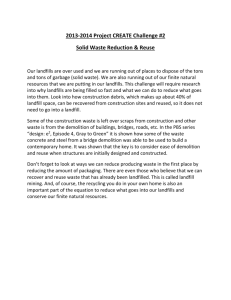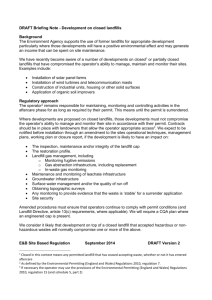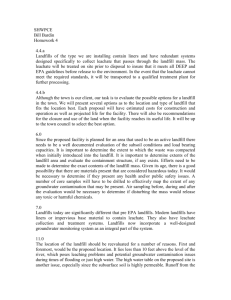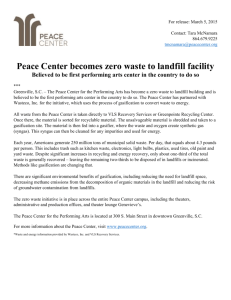Allied Waste Services Local Event Analysis: Landfills
advertisement
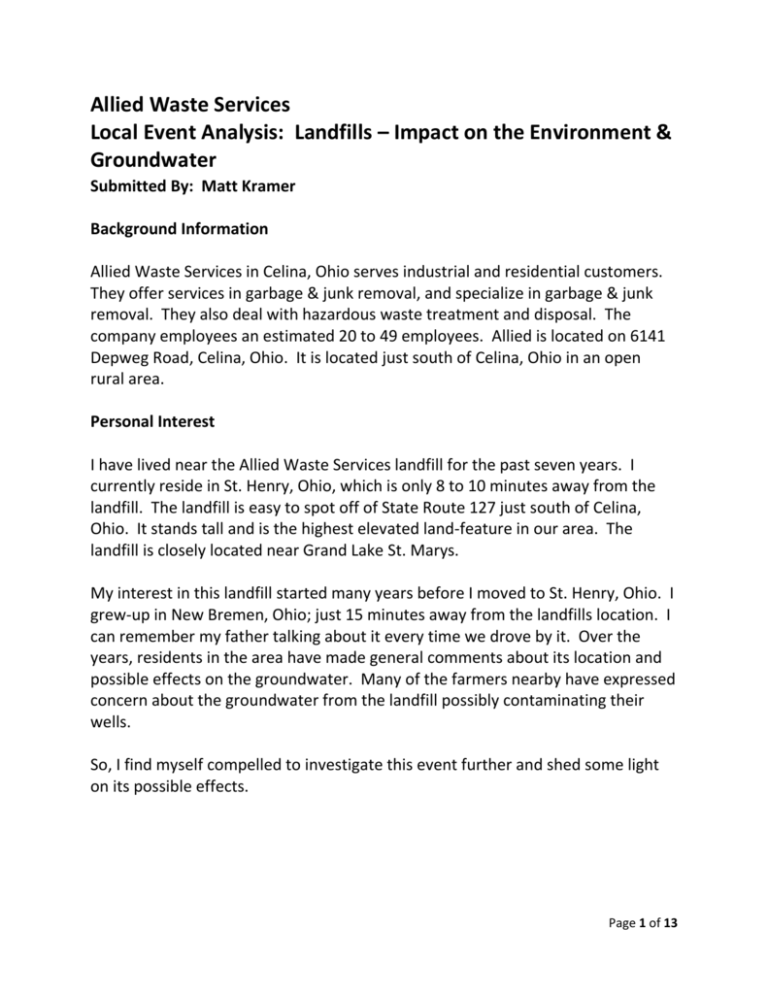
Allied Waste Services Local Event Analysis: Landfills – Impact on the Environment & Groundwater Submitted By: Matt Kramer Background Information Allied Waste Services in Celina, Ohio serves industrial and residential customers. They offer services in garbage & junk removal, and specialize in garbage & junk removal. They also deal with hazardous waste treatment and disposal. The company employees an estimated 20 to 49 employees. Allied is located on 6141 Depweg Road, Celina, Ohio. It is located just south of Celina, Ohio in an open rural area. Personal Interest I have lived near the Allied Waste Services landfill for the past seven years. I currently reside in St. Henry, Ohio, which is only 8 to 10 minutes away from the landfill. The landfill is easy to spot off of State Route 127 just south of Celina, Ohio. It stands tall and is the highest elevated land-feature in our area. The landfill is closely located near Grand Lake St. Marys. My interest in this landfill started many years before I moved to St. Henry, Ohio. I grew-up in New Bremen, Ohio; just 15 minutes away from the landfills location. I can remember my father talking about it every time we drove by it. Over the years, residents in the area have made general comments about its location and possible effects on the groundwater. Many of the farmers nearby have expressed concern about the groundwater from the landfill possibly contaminating their wells. So, I find myself compelled to investigate this event further and shed some light on its possible effects. Page 1 of 13 What is a Landfill? According to Zero Waste America’s web site, a landfill is a carefully designed structure built into or on top of the ground in which trash is isolated from the surrounding environment. ESS Analysis on Allied Waste Services Landfill, Celina, Ohio Event: Landfills Impact on the Environment and Groundwater Causal Chain Interactions E>L>H>H>B&A What impacts do landfills have on the environment and groundwater? The urban and industrial trash and garbage waste has to go somewhere. As a result of this, landfills have been a common solution for many years. The waste products are altering the composition of the earth. The soil layers are being disrupted unnaturally by human activity. According to a website article, Our Land, Our Bodies, written by Francesca Lyman (a MSNBC.com contributor), there are more than 70,000 chemicals in use in the United States and 2,000 new compounds are being introduced every year. That means those chemicals are making their way, eventually, into our landfills, further contaminating our soils. Municipal solid waste (MSW) landfills accept nonhazardous wastes from a variety of sources, such as households, businesses, restaurants, medical facilities, and schools. According to Water Encyclopedia.com, MSW landfills also accept contaminated soil from gasoline spills, conditionally exempted hazardous waste from businesses, small quantities of hazardous waste from households, and other toxic wastes. (Read more: Landfills: Impact on Groundwater - types, system, source, oxygen, human http://www.waterencyclopedia.com/La-Mi/Landfills-Impact-onGroundwater.html#ixzz143DfsVmp) What happens when the waste materials begin to breakdown due to water saturation into the soil and waste? The precipitation that falls into a landfill, coupled with any disposed liquid waste, results in the extraction of the watersoluble compounds and particulate matter of the waste, and the subsequent formation of leachate (http://www.waterencyclopedia.com/La-Mi/LandfillsImpact-on-Groundwater.html). Leachate is also known as “garbage soup”. Page 2 of 13 Leachate is the by-product of water that has filtered through the waste material. It poses a great threat to current and future groundwater quality. Most landfills are required to have some sort of liner to prevent leachate from escaping. Some liners are clay, plastic, and composite (a mix of plastic and clay). Plastic landfill liners are 100 mils or 1/10 of an inch thick. “82% of surveyed landfill cells had leaks while 41% had a leak area of more than 1 square feet," according to Leak Location Services, Inc. (LLSI) website (March 15, 2000). Picture from http://www.ottawaskeptics.org/the-reality-check?start=70 Ultimately, the liners will naturally breakdown and chemicals and gases will aide in this process allowing leachate to escape into the soil. Old and new landfills are typically located next to large bodies of water (i.e., rivers, lakes, bays, etc.), making leakage detection and remediation (clean-up) extremely difficult. Page 3 of 13 Eventually the leachate will make its way into the groundwater. This not only poses a threat to the environment, but also human & living life. Hazardous & nonhazardous components of leachate could destroy an aquifer for drinking water usage. Since leachate detection is difficult to monitor, living things may have already been affected without even knowing for some time. Aquatic species may also be harmed. Contaminated groundwater could make its way to wetlands or streams allowing it to migrate further. Other impacts that would also affect the atmosphere which also affect the biosphere would be the off gassing of methane generated by decaying organic wastes (methane is a greenhouse gas many times more potent than carbon dioxide, and can itself be a danger to inhabitants of an area), and harbouring of disease vectors such as rats and flies. (http://en.wikipedia.org/wiki/Landfill) As you can see, the impacts of landfills are cause for great concern, not only for today, but for our future. Sources: http://www.zerowasteamerica.org/BasicsOfLandfills.htm http://www.waterencyclopedia.com/La-Mi/Landfills-Impact-onGroundwater.html http://www.msnbc.msn.com/id/3076636/ http://en.wikipedia.org/wiki/Landfill Page 4 of 13 Classroom Application Allied Waste Services Landfills – Impact on the Environment & Groundwater Submitted By: Matt Kramer Curriculum Connection Ohio Standard: Earth Science (Earth Systems Ladder: Resources) Benchmark D: Describe the finite nature of Earth’s resources and those human activities that can conserve or deplete Earth’s resources. Indicator 10.5: Explain how the acquisition and use of resources, urban growth and waste disposal can accelerate natural change and impact the quality of life. Indicator 10.6: Describe ways that human activity can alter biogeochemical cycles (e.g., carbon and nitrogen cycles) as well as food webs and energy pyramids (e.g., pest control, legume rotation crops vs. chemical fertilizers). The focus of applying this event to the classroom will tie into the above Ohio indicators based on the 10th grade level (sophomores). The primary focus taken from each indicator will be how human activities can deplete Earth’s resources (namely water quality), how human activity can alter biogeochemical cycles specifically through the use of man-made chemicals and natural wastes, and how waste disposal can accelerate natural change and impact the quality of life. Many of the disciplines from earth, life, and physical sciences to language arts and math will be explored and exposed through the activities the students will be conducting. The students will explore the effects of this event (Landfills impact on the environment and groundwater.) on the various sciences that have been taught to the students throughout their grade school years. Unit Goal The students will explore and explain the cause and effects that landfills have on the environment and groundwater. Page 5 of 13 Engaging the Students to the Topic Many of the students from the area are very familiar with the landfill and have heard parents, grandparents, friends, and neighbors talk about it; whether it is negative or positive comments. A clever little hook I would use, and have written on the board as the students walked in, would be, “Trash Talking!” This phrase would be sure to catch the students’ attention since most students would think of this in a negative manner and in a different context. So, to engage the students into the topic I would have them watch a short video (entitled Landfills Demo) from this website, http://www.landfill-site.com/html/landfill_videos.php. This video can also be viewed from YouTube. Once the video has been viewed, explain the objective of this topic: The students will explore and explain the cause and effects that landfills have on the environment and groundwater. And, I would draw students’ attention to the landfill just south of Celina, Ohio. Instructional Strategy After engaging the students, I would introduce the students to the local landfill just south of Celina, Ohio. I would have them read the background information on the landfill. Then, I would have the students read the causal chain of events related to landfills. See below: Background Information Allied Waste Services in Celina, Ohio serves industrial and residential customers. They offer services in garbage & junk removal, and specialize in garbage & junk removal. They also deal with hazardous waste treatment and disposal. The company employees an estimated 20 to 49 employees. Allied is located on 6141 Depweg Road, Celina, Ohio. It is located just south of Celina, Ohio in an open rural area. Analysis on Allied Waste Services Landfill, Celina, Ohio Event: Landfills Impact on the Environment and Groundwater Causal Chain Interactions E>L>H>H>B&A What impacts do landfills have on the environment and groundwater? The urban and industrial trash and garbage waste has to go somewhere. As a result of this, landfills have been a common solution for many Page 6 of 13 years. The waste products are altering the composition of the earth. The soil layers are being disrupted un-naturally by human activity. According to a website article, Our Land, Our Bodies, written by Francesca Lyman (a MSNBC.com contributor), there are more than 70,000 chemicals in use in the United States and 2,000 new compounds are being introduced every year. That means those chemicals are making their way, eventually, into our landfills, further contaminating our soils. Municipal solid waste (MSW) landfills accept nonhazardous wastes from a variety of sources, such as households, businesses, restaurants, medical facilities, and schools. According to Water Encyclopedia.com, MSW landfills also accept contaminated soil from gasoline spills, conditionally exempted hazardous waste from businesses, small quantities of hazardous waste from households, and other toxic wastes. (Read more: Landfills: Impact on Groundwater - types, system, source, oxygen, human http://www.waterencyclopedia.com/La-Mi/Landfills-Impact-on-Groundwater.html#ixzz143DfsVmp) What happens when the waste materials begin to breakdown due to water saturation into the soil and waste? The precipitation that falls into a landfill, coupled with any disposed liquid waste, results in the extraction of the water-soluble compounds and particulate matter of the waste, and the subsequent formation of leachate (http://www.waterencyclopedia.com/La-Mi/Landfills-Impact-onGroundwater.html). Leachate is also known as “garbage soup”. Leachate is the by-product of water that has filtered through the waste material. It poses a great threat to current and future groundwater quality. Most landfills are required to have some sort of liner to prevent leachate from escaping. Some liners are clay, plastic, and composite (a mix of plastic and clay). Plastic landfill liners are 100 mils or 1/10 of an inch thick. “82% of surveyed landfill cells had leaks while 41% had a leak area of more than 1 square feet," according to Leak Location Services, Inc. (LLSI) website (March 15, 2000). Picture from http://www.ottawaskeptics.org/thereality-check?start=70 Ultimately, the liners will naturally breakdown and chemicals and gases will aide in this process allowing leachate to escape into the soil. Old and new landfills are typically located next to large bodies of water (i.e., rivers, lakes, bays, etc.), making leakage detection and remediation (clean-up) extremely difficult. Eventually the leachate will make its way into the groundwater. This not only poses a threat to the environment, but also human & living life. Hazardous & nonhazardous components of leachate could destroy an aquifer for drinking water usage. Since leachate detection is difficult to monitor, living things may have already been affected without even knowing for some time. Aquatic species may also be harmed. Contaminated groundwater could make its way to wetlands or streams allowing it to migrate further. Other impacts that would also affect the atmosphere which also affect the biosphere Page 7 of 13 would be the off gassing of methane generated by decaying organic wastes (methane is a greenhouse gas many times more potent than carbon dioxide, and can itself be a danger to inhabitants of an area), and harbouring of disease vectors such as rats and flies. (http://en.wikipedia.org/wiki/Landfill) As you can see, the impacts of landfills are cause for great concern, not only for today, but for our future. Sources: http://www.zerowasteamerica.org/BasicsOfLandfills.htm http://www.waterencyclopedia.com/La-Mi/Landfills-Impact-on-Groundwater.html http://www.msnbc.msn.com/id/3076636/ http://en.wikipedia.org/wiki/Landfill This event should really perk their attention, since most are very familiar with this landfill and its location nearby. When students have finally read the scenario allow students time to discuss their thoughts. Many of them probably have strong opinions to this event. Next, briefly revisit the science disciplines (earth, life, and physical sciences) and the spheres (atmosphere, lithosphere, hydrosphere, and biosphere) the students have had for many grade school years. Go over the meaning and importance of each one. (This could take a full lesson in itself.) Student Activity: Jigsaw Teach. Have the students begin investigating how this event (Landfills impact on the environment and groundwater.) affects the many spheres. How does it affect the hydrosphere (water on Earth), lithosphere (Earth’s land), biosphere (living things), and atmosphere (air)? I would really encourage the students to study the causal chain of interactions that were introduced early with the background information. 1. Divide students into sphere groups. Each student will be assigned to a sphere group. Each group will be responsible for investigating and explaining how their sphere is affected by the event at the landfill (Allied Waste Services). The students will teach each other what they have learned and will become the experts for their sphere. 2. Students will first have to identify the causes that bring about these effects. For example, leachate. What causes leachate to form? 3. After students have identified the probable cause(s), they will investigate how their sphere is affected by landfills. The students become the experts for their Page 8 of 13 sphere and teach the other classmates how their sphere is affected by the event. Students will also be responsible for developing how they will present their information to the class. (This will connect the language arts discipline using various skills such as summarizing and organizing data.) The teacher will want to help generate ideas on how it could be presented. The students will be given many resources from websites to explore and investigate. Resources for students to use: http://www.zerowasteamerica.org/BasicsOfLandfills.htm http://www.waterencyclopedia.com/La-Mi/Landfills-Impact-onGroundwater.html http://en.wikipedia.org/wiki/Landfill http://www.landfill-site.com/html/landfill_videos.php http://www.epa.gov/osw/nonhaz/municipal/ http://www.knowledgegalaxy.net/landfill_facts/landfill_facts.html http://www.justlivegreener.com/environment/253-scary-facts-aboutlandfills.html Assessment: Teacher observation of cooperative group learning, how the students presented their material (visuals, outline, graphic organizer, etc.), the number of effects the cause may have, and the depth of reasoning behind each effect on the sphere. See Rubric for Jigsaw Teach Assessment of this activity. (next page) Page 9 of 13 Rubric for Jigsaw Teach Assessment: POINTS Group Cooperation Presentation of Information Number of Effects from the Cause Depth of Reasoning Behind Each Effect on the Sphere 4 3 2 1 Student took on leadership role, collaborated well with others, quality research & edited ideas. Students used visuals such as pictures, charts, graphs, diagrams, organizers, etc. to present info. Students identified four effects from the cause. Student helped to organize some ideas and edit them. Quality research input. Student did little research and provided little input to ideas. Student did no research. Good listener, but added no additional input. Students used an organizer to present their information and a visual. Students used a graphic organizer, but no visuals to present information. Students did not use visuals or a graphic organizer to present information. Students identified three effects from the cause. Students identified two effects from the cause. Students identified one effect from the cause. Students provided multiple examples to explain their effect with multiple cited sources. Students provided multiple examples to explain their effect with a few cited sources. Students provided an example to explain their effect with one cited source. Students provided no examples to explain their effect with no cited sources. *Scoring: Take the rubric score total from all four criteria areas and multiply it by 5. (For example, the student received a rubric score total of 15. Times 15 by 5 = 75. Total point value possible is 80.) Extension Activity: In this activity, students will identify what components make a landfill sanitary (Meaning how it is going to be lined, what waste products are acceptable, and how the leachate is going to be dealt with), draw a diagram of a sanitary landfill (refer to the components), and construct a model of a landfill. Resources to Consult: U.S. Environmental Protection Agency “Terms of Environment” (http://www.epa.gov/OCEPAterms/) and state municipal solid waste data (http://www.epa.gov/epaoswer/non-hw/muncpl/states.htm). How Stuff Works (http://people.howstuffworks.com/landfill.htm) The Solid Waste Association of North America (http://swana.org/) Page 10 of 13 Suggested Materials for Model Construction (but not limited to): clear plastic container, large sheet of clear plastic, enough modeling clay to cover the bottom and top of the container, enough potting soil to make three or four layers in each container, paper scraps and other refuse scraps (do not include food or organic waste), plastic straws of various sizes, grass seed (optional) Procedure: Students will be in groups of 3 or 4. Students will identify what components make a landfill sanitary (Meaning how it is going to be lined, what waste products are acceptable, and how the leachate is going to be dealt with). Draw a diagram of a sanitary landfill (refer to the components). Students will construct a model of a landfill. Students will use their diagrams to assist in constructing their landfill model. Do not give them instructions on how to construct their model. Allow them to design this using the materials they chose, based on their diagram. Assessment: See Extension Assessment Rubric Key Components to look for when evaluating students landfill models: Clay should line the bottom of the container. Then, the plastic will line the bottom and sides. The straws represent the leachate, groundwater, and methane collection equipment and should be placed so that they extend above the surface of the completed landfill. Next, students should layer the waste material and potting soil. The final layer of the landfill is covered with clay followed by top soil. Students may wish to plant grass seed on this layer and decorate it to represent a golf course, etc. Extension Assessment Rubric POINTS 4 3 Group Cooperation Student took on leadership role, collaborated well with others, quality research & Student helped to organize some ideas and edit them. Quality research input. 2 Student did little research and provided little input to ideas. 1 Student did no research. Good listener, but added no additional input. Page 11 of 13 edited ideas. Components of a Sanitary Landfill Diagram of a Landfill Constructed Model of a Landfill Students identified waste materials, leachate, liners, and clay base. Students identified 3 of the 4 items mentioned in a rubric score of 4. Students identified 2 of the 4 items mentioned in a rubric score of 4. Students identified 1 of the 4 items mentioned in a rubric score of 4. Students drew & labeled waste materials, a leachate removal system, liners, soil layering, and a clay base. Students included waste materials, a leachate removal system, liners, soil layering, and a clay base. Students drew & labeled all of the items mentioned in a rubric score of 4, except for 1. Students drew & labeled some of the items mentioned in a rubric score of 4. Almost half. Students drew & labeled a few items needed for a rubric score of 4. Students all of the items mentioned in a rubric score of 4, except for 1. Students included some of the items mentioned in a rubric score of 4. Almost half. Students included a few items needed for a rubric score of 4. *Scoring: Take the rubric score total from all four criteria areas and multiply it by 5. (For example, the student received a rubric score total of 15. Times 15 by 5 = 75. Total point value possible is 80.) Page 12 of 13 Reflection Submitted By: Matt Kramer Initial Thoughts & What I Have Learned Now, having completed two modules, I feel that I’m in the frame of mind that a true scientist may be in. I no longer look at an event the same way. I question how something happens, why something happens, and what effects are results of it. I never used to look at something and question how it would affect another sphere, and how another sphere would affect another sphere. The interconnections between everything on Earth are vast. I have learned that many resources and research are keys to understanding and are crucial to providing support and evidence when making a statement. There needs to be some sort of backing behind what you say. How Have I Learned About Earth System Science? I have learned about earth system science through many avenues as this course has progressed. From the two modules (Coral Reefs and Ice Sheets) I have learned how to make connections between events and spheres, spheres to events, and spheres to spheres. I have learned about causal chains and how one event can set a whole train in motion with literally no ending. They affect so many things. I have learned earth system science through my peers. Our discussions and differing point of views has been very beneficial. We learn a lot from our peers. Each person has so much to offer and a different view point. I have also learned much about earth system science through the many resources that have been provided or researched by myself and peers. Ice Sheets Module Before this module, I knew very little about ice sheets, except for what I’ve seen on TV and what I’ve learned through Dr. Hauser’s Glacial Landforms class. When you refer back to my prior knowledge of ice sheets, you will notice that my interactions are limited in depth. *I was so excited the other week when one of my students asked me why Antarctica and the Arctic regions were mostly ice. I actually felt comfortable giving them answers and responses. I will now look at ice sheets and think what effects they could have, short and long term. Page 13 of 13

